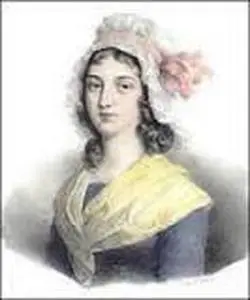
Figure 1: Pauline Leon, portrait
The Storming of the Bastille symbolized the flashpoint of the French Revolution, which showcased the radical patriotism and republicanism that would resonate throughout France for decades. The Revolution introduced radical ideologies that emerged as a reaction to the oppressive governance of the Monarch, Louis XVI. The Storming of the Bastille represented French radical leftism by featuring unprecedented enthusiasm for revolution as well as revolutionaries, anomalous to the period. Anne Pauline Léon, born a chocolate maker, engaged in the leftist violence and political movements that defined the Revolution. Pauline Léon participated in the Storming of the Bastille by carrying a pike, engaging in violent action, and protesting the systematic injustices propagated by the Monarch. Léon’s role in the French Revolution exhibited the general attitudes of contemporary revolutionaries, while simultaneously showing the internal conflict regarding the role of femininity in the Republican movement. The shift in the French political landscape displayed not only the growing radical leftism, but also an emphasis on the social and political role of women in post-monarch France. Léon embodied the political radicalism by participating in protests against the Monarch, condoning violence against the aristocratic class, and drifting towards the enragés, while struggling with the normalized gender inequality, which influenced her ideology regarding the extent of women’s participation in politics.
Pauline Léon was defined by her militancy, patriotism and radical republicanism, which distinguished her as a revolutionary woman during a conflict directed predominantly by men. Her condemnation of the monarch, the Marquis de Lafayette, and counter-revolutionaries showed her devotion to the Revolution, but often has been mistaken for women’s rights activism. Léon called for systematic politics of terror to be infringed upon enemies of the republic, including the Girondins, aristocrats, and hoarders (ed. Levy, Applewhite, Johnson 1976, 150). The mistake, however, originated from her involvement in gender politics during the Revolution. Léon did not initially attempt to give women an active role in politics, but rather a distinctly defensive role. Although Léon facilitated a society dedicated to amplifying women’s voices in the revolution and advocated for a women’s right to defend the Fatherland, or the patrie, she held some fundamentally traditionalist beliefs regarding domestic life. She embodied the characteristics of traditional French social values by condemning women who followed in her footsteps, but contradictorily championed the importance women play in the defense of the patrie and the revolution. Enlightenment thinkers painted women as destined to play domestic roles, which therefore strengthened gender norms that were based on the belief that women were inherently inferior, and shaped the normalized roles that would have conditioned Léon (GMU, 1). Although the legitimacy of these assertions had dissipated some since the Enlightenment, the normalized domesticity of women still tainted their political activity, as well as their own values. Léon’s militancy and radicalism juxtaposed with traditional domestic values exposed the restraints still prevalent and normalized during the revolution. However, the social concessions did not devalue her legacy as a prominent woman during the Revolution.
The rhetoric regarding politics and gender during the Revolution reflected the complex political atmosphere which the women revolutionaries inhabited. The movement for extended rights was met with adversity, hostility, and doubts from the institutionalized patriarchy of France. The Republic did not initially grant women first-class citizenship, meaning that women did not share the same political rights as men, such as voting, bearing arms, or access to public office. However, the Revolution inspired women to demand political equality, or simply to be recognized as essential components of the Republic. Léon and other women revolutionaries faced tremendous boundaries when advocating for women’s right to political involvement, which generated complex relationships between gender norms and extended political activity. Pauline Léon, like her colleagues, was forced to negotiate their demands for political equality with the systemic oppression of femininity, therefore defining their pleas as more political and less gendered.
Some of Léon’s revolutionary ideology can be attributed to her father’s philosophical teachings, which she claimed “did not leave [her] with any prejudices” (Léon, ed. Levy, Applewhite, Johnson 1979, 158). Her mother was widowed during Léon’s early life, which left her to take care of her fathers’ chocolate-manufacturing business as well as her family, which included her five siblings. She inherited independence, distinguishing her from many women during the late eighteenth century. Without the heavy patriarchal influence, she became a revolutionary, motivated by her dissatisfaction with women’s absence in politics, that chose a life of independence rather than living as a subsidiary to her father until she married. Candice Proctor characterized Léon as what would later be called an “emancipated woman,” or simply a woman who rejected normalized and dependent political roles for women (Proctor 2000, 46). Her independence allowed her to seize an active role in the Storm of Bastille in 1789 and the Champ de Mars congregation in 1791 by taking arms, which solidified her belief that woman ought not idly sit by while tyranny threatened freedom and the Revolution. Universally, to Léon, citizenship meant the responsibility of protecting the patrie, regardless of class or gender, even though she did believe there was a difference between those responsibilities. Proctor related Léon’s actions to women of lower classes because sans-cullote, or working class, women were more given to action instead of exclusively participating in speeches and peaceful protests (Proctor 2000, 48).After her father’s death, Léon could freely participate in the Revolution, so she militarized because she believed that women should not be complicit and should embrace their citizenship by weaponizing against tyranny.
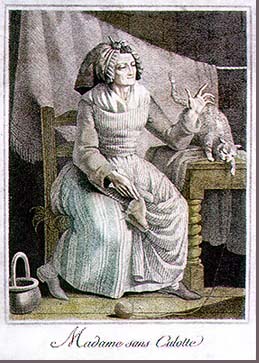
Figure 2: Madame Sans-culotte; represented the domesticity desired by urban male revolutionaries, but the sans-culotte women would adopt a gallant attitude nearing the Women’s March on Versailles. (GMU, 2)
As an advocate for women’s rights during the Revolution, Léon’s radicalism focused solely on the Revolution in French politics instead of specifically addressing the institutionalized oppression of women from the Enlightenment period. Léon prioritized the revolution over women’s rights activism, which added to the perpetuation of gender roles into Revolutionary and post-Revolutionary France. The limited advocation for women’s rights allowed for the opposing and sexist norms to maintain political weight. Other women revolutionaries during the time period also displayed a checked view on the extent women should be political, including Olympe de Gouge, who declared that “women today are mixing in the public assemblies and clubs: they are deserting their homes, it is necessary to lead them back there”[Proctor 2000, 61]. The embedded sexism appeared when Leon exclaimed that “The rhetoric of the Revolution must be applied to both sexes equally, or risk accusation of hypocrisy and ultimate failure,” and that regardless of the natural traits of women, their “courage and intrepidity will supplement [their weakness],” which presented the idea that women must be a part of the Revolution and the Republic and held an integral role of the future of France. (Proctor 2000, 48-50). In the preceding quote, however, Léon implied that women have an inherent weakness in comparison to men. The subtle constraints implicitly exposed by Léon’s words showed how gender norms still delimited her radicalism, and exposed the contemporary difficulties of negotiating the rights of women in a society that systematically limited the political potential of women. At the time of the French Revolution, the lines between masculinity and femininity were established by an inelastic gender binary. The hierarchical system taught that men were intrinsically superior, meaning that the inequality ingrained within society continued to block the women revolutionaries’ attempts at political equality, both systematically and through social constraints. Although Léon differentiated from the traditional views to a substantial extent, she still perpetuated the ideology that deemed men and women fundamentally different.
Léon exhibited the revolutionary dedication to resist the monarch and dismantle its authority, notably through violent radicalism, unmatched by many male counterparts. She recalled in 1794 that she felt suspect about the Marquis de Lafayette, and finally her suspicions were confirmed during the October Days, or the Women’s March on Versailles in 1789. She exclaimed that she swore to herself “to eternal hatred of him, and I have used all my possible means to unmask him” (Léon, ed. Levy, Applewhite, Johnson 1979, 159). She called for violence and institutional terror against the monarch and continued to encourage the violent punishment of counterrevolutionaries. While attempting to persuade the National Assembly to allow women to bear arms, she declared that if women were denied the right to bear arms, they would die “regretting not life, but the uselessness of their death; regretting moreover, not having been able to drench their hand in the impure blood of the enemies of the fatherland” (Léon, ed. Levy, Applewhite, Johnson 1979, 73). The radical assertions and militancy of Léon and the society provided the ammunition to their adversaries. The adversaries strengthened as Léon’s marital commitment associated the Society too closely to the enragés and Théophile Leclerc. Léon’s emphasis on martial politics incited skepticism simply because she was a woman, deemed less responsible than Jacobin leaders carrying out the Reign of Terror, but through her marital commitments, her skeptics could condemn her action as “dangerously radical.”
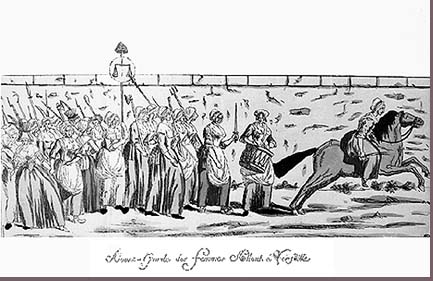
Figure 3: Women’s March on Versailles, 1789; During October of 1789, massive crowds of women demanded liberal reforms. Pauline Leon was in attendance. (GMU)
Léon advocated that women deserved to participate in the defense against tyranny in order to protect the patrie. The specific roles she suggested for women, however, often reflected the gender-normative, sexist, and dependent expectations placed onto women, which heavily influenced revolutionary thinking, even from the radical leftist thinkers. She embodied the radicalism of the revolution, but fell prey to the gender roles established during this time period. Jennifer Heuer stated that the declaration of the Republic in 1792 introduced the word citoyennes as a counterpart to the masculine title, citoyen. This indirectly provided the justification and space for women to congregate and participate in revolutionary politics even though the term intended to discredit women, not enfranchise them (Heuer 2005, 49). The term came to mean that women did, however, have a right to citizenship, or political participation. Even prior to the declaration, Léon and other women began to petition for rights to participate in the protection of the Fatherland. She demonstrated her radical ideals regarding women’s rights when she petitioned the National Assembly and demanded the right to formulate a female militia in order to combat tyranny. She declared that they “demand only the honor of sharing [men’s] exhaustion and glorious labors,” and the opportunity to shed blood, which highlighted her primary concern: political opportunity (Léon, ed. Levy, Applewhite, Johnson 1976, 74). Although her petition failed, her arguments reflected how her radical ideology was constrained to the contemporary view of gender roles. The dissenters in the National Assembly denounced Léon’s claims to rights by stating that women would abandon their homes and families. Léon retorted, “We wish only to defend ourselves the same as you; you cannot refuse us, and society cannot deny the right nature gives us, unless you pretend the Declaration of Rights does not apply to women, and that they should let their throats be cut like lambs, without the right to defend themselves” (McMillan 2002, 20). She condemned her dissenters by accusing them of dehumanizing women by not granting them rights, which defended the humanity and political potential of women, but still stated that their purpose was to defend, which would be relatively inactive compared to male revolutionaries. Léon’s political career was tainted by the patriarchal social environment, and although she rebelled against the patriarch, she still conceded to the male politicians because she was forced to negotiate her own radicalism against embedded gender norms.
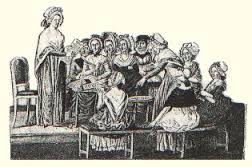
Figure 4: The Society of Republican and Revolutionary Women (Mt. Holyoke)
Léon and her partner, Clare Lacombe, believed that women could not act indifferent in opposition to tyranny and should have the right to serve the Fatherland, however, advocated for the right to defend instead of the right to “run and face the enemy” (Léon, ed. Levy, Applewhite, Johnson 1979, 73). Léon, almost contradictorily so, held domestic virtues in high esteem. Although she remained an “emancipated,” extremely political, and single woman during her youth, she eventually married Théophile Leclerc, who led the enragés, a radical leftist organization that protected the common people. After her marriage, she became less political publicly. She still maintained a high level of enthusiasm for the Revolution, but became publicly dependent in comparison to her youth. Leon expressed these values in 1794, after she was arrested, when stating that she had devoted herself “altogether to the care of my household, and I set an example of the conjugal love and domestic virtues which are the foundation for love of the Fatherland” (Léon, ed. Levy Applewhite, Johnson 1976, 160). The statement appeared to contradict Léon’s initial beliefs relating to the mobilizing and weaponizing of women to protect the Fatherland. The contradiction, however, showed the pressures that Léon was forced to confront, forcing her to yield to systemic oppression. Although her statements seemed antithetical to her own experiences of political autonomy, they reflected similar sentiments of women revolutionaries in the later years of the Revolution. Léon and the prominent revolutionary women denounced the large number of women who congregated and ignored marital virtues. The traditional criticism coming from Léon differed from her activism, and her own life as an independent, revolutionary woman. The critiques towards congregating women displayed how even though she supported radicalism in the revolution, her views were still suppressed by a patriarchal France.
Early political societies and revolutionary organizations included women, but did not provide them with a voice equal to that of a citoyen, or a republican man. Léon and Clare Lacombe organized the Société des Citoyennes Républicaines Révolutionnaires, or the Society of Revolutionary Republican Women. Léon and Clare Lacombe organized the society to disrupt the monarch, Lafayette, and supporters of the tyrannical government, and to resist any form of oppression that the Revolution meant to abolish. They debuted the organization in Paris during May of 1793 by exclaiming that, “The Society has for its objective deliberation on the means of frustrating the projects of the republic’s enemies” (Godineau 1998). The society allowed women to amplify their voices during the Revolution only for five months. The introduction of an organization dedicated to women’s rights in France was novel. Léon and the other members of the society faced dissension and antagonism from multiple other revolutionary organizations, including the Jacobins. Although the Society and the Jacobins both wanted to severely punish hoarders and to combat rapid inflation, the Jacobins feared that the women’s club would drastically radicalize if they allied with the enragés. This also could be attributed to sexist assumptions of women that characterized women as reckless. The alliance could have propelled the Revolution and France radically to the left, which would result in severe policing of grains, an acceleration of terror, and possibly the reapplication of the radical constitution of 1793 (Heuer 1989, 25). The Jacobins feared the organization simply because they feared women would demand too much. The Jacobins initially supported the women’s club, but as their influence grew, retreated to the systematic hierarchy in order to ensure their male dominance. Léon’s radicalization originated from her original condemnation of tyranny, which ignited the Revolution, and as the Jacobin’s dismissed and denounced her Society, she and the Société des Citoyennes Républicaines Révolutionnaires continued to shift left towards radicalism, militancy, and the enragés.
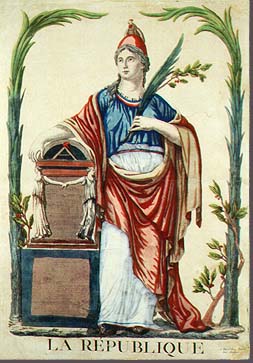
Figure 5: La Republique; Lady Liberty was made not to represent women revolutionaries, but rather to depict a matriarchal, protecting figure and to avoid depicting similarities of any male politician. (GMU, 4)
Léon prioritized the ideology of the Revolution instead of women’s rights due to both social conditioning, and her vehement detestation of tyranny and the monarch. Politics were the priority, not gender. Her militancy resonated through regulations and actions of the Société des Citoyennes Républicaines Révolutionnaires. The regulations and the oath illustrated the commitment necessary to join and participate in the Society. New members were required to state an oath which read, “I swear to live for the Republic or die for it” (Léon, ed. Levy, Applewhite, Johnson 1979, 163). The women’s dedication to the Republic and the Revolution stemmed from their belief that their contributions were crucial to the Republic’s survival. The Republican and Revolutionary women felt universally affected by the violence caused by the monarch and thought that, regardless of their femininity, they reserved the right to defend the Fatherland. The elements of the Society demonstrated that they believed that regardless of gender, that dedication to the Revolution and the dismantling of tyranny, or aristocratic class, should be their initiative. The societies provided a space where politically autonomous women could assemble and petition for the expansion of their rights in the republican government, but failed to sustain itself due to external pressures of the patriarchy and leftists that opposed their radicalization.
Jacobin criticism of Léon and Lacombe centered on the women’s tightening connections with the enragés, which threatened relatively moderate revolutionaries. The radical leftist ideology of the enragés was widely seen as counterrevolutionary. The Jacobins perpetuated those claims and eventually extended them to Léon and her society. Léon and the Society drifted farther from the Jacobins following the death of extreme leftist Jean-Paul Marat. The Society admired Marat, and his death helped push them towards the enragés because it engendered doubts in the capacity of the Jacobin’s political platform. The Society and the enragés shared approximately the same ideology, economically and politically. The two organizations found commonality in their militant and radical practices and movements, which solidified their strong connection (Proctor 2000, 157). The enragés also believed that women must play an active and integral role in the Revolution, which appealed to Léon and the Society. Léon married Leclerc, which publicly entangled the two organizations and reversed the acclamation the Society and Léon once received from members of the Jacobins. The way the public attributed the entire Society of Republican Women to the enragés revealed how women during the time period could easily be treated as subsidiaries to their husbands, even if Léon contributed a substantial amount to the Revolution. Léon’s ideology radicalized to the point of clear and public opposition towards the other organizations on the left. She stated that, “We no longer believe in the virtue of those men who are reduced to praising themselves,” condemning Jacobin leaders of corruption and personal ambition (Proctor 2000, 157). Her accusations created enemies that would condemn her actions, which directly culminated in the dissolution of the Society.
Léon’s entanglements with Leclerc and her antagonization of the Jacobins eventually engendered the ammunition for criticism that was necessary to dismantle her revolutionary status as well as her Society. Her denouncement prompted restrictive policing and beliefs regarding women’s involvement in the revolution. The Jacobins began to spread accusations that she was a counterrevolutionary. Former allies and women petitioned the Convention to dismantle the Société des Citoyennes Républicaines Révolutionnaires. The champions of sexual and gender equality in politics failed to solidify their impact. The militancy of the Society and Léon resulted in the declaration that banned all congregations of women. They challenged the patriarchal system, and thereby threatened masculinity, which incited the political attack on women. Proctor stated that the value of gender equality in politics had seemingly been discredited by the nature of the Revolution (Proctor 2000, 176). The opposition to the political rights of women stemmed from traditional marital virtues, ironically the same virtues esteemed by the revolutionary women. Jean-Baptiste Amar’s decree to suppress all women’s clubs justified the silencing of women through traditional gender roles and the condemnation the Society’s radicalizing leftism. He proposed the decree that would suppress women’s right to assembly to the Committee of Public Security. The decree dismantled the female societies in France, and shattered their contemporary political standing. Amar declared in his decree that all women “are hardly capable of lofty conceptions and serious cogitations,” so women were incapable of participating in French politics due to their “natural timidity” (Amar, ed. Hunt 1996, 135-138). The decree passed with virtually no opposition. Proctor asserts that the “French Revolution only reinforced traditional conceptualization of the female” (Proctor 2000, 179). The violent reaction to femininity and radical leftism left Pauline Léon deemed as a counterrevolutionary, contrary to the initial support she encountered as a revolutionary woman. The Society incidentally perpetuated the traditionalist constraints put on women. The Jacobins and Amar successfully associated Léon and the Société des Citoyennes Républicaines Révolutionnaires with dangerous radicalism, and traditional sexist attributions of recklessness and timidity. However, their radicalization precipitated the drastic reaction from Revolutionary leaders.
Pauline Léon depicted the drastically changing role of women incited by the French Revolution in 1789. Her contributions to feminism, gender equality, and political activity for women are illustrated through her impassioned ideology and activism that inspired women to take on an independent role in politics. Although Léon maintained traditional views on gender roles and marital virtues, Léon actively advocated for the intensification of female participation on the basis that the Revolution could only survive with the combined efforts of men and women. Despite her beliefs that men and women were inherently different, she argued for equal opportunity and accessibility of political rights for both men and women. Throughout the Revolution, Léon helped legitimize the participation of revolutionary women by facilitating their voice through her own activism and through the development of the Société des Citoyennes Républicaines Révolutionnaires. Nevertheless, her own traditional beliefs, her marriage to enragés leader Theophilé Leclerc, and rapid radicalization engendered the hostility that ended with the dissolution of the Society as well as the traditionalist retaliation that reversed the progress of gender rights. Léon’s legacy ultimately revealed a revolutionary woman whose ideology displayed unprecedented radicalism and Republicanism through femininity even if it was eventually rejected and denounced due to not only her enhanced militancy, but the systemic subjugation of femininity.
Bibliography
Amar, Jean-Baptiste. Translated, edited, and with an introduction by Lynn Hunt. The French Revolution and Human Rights: A Brief Documentary History. Boston/New York: Bedford/St. Martin’s, 1996. Print
GMU. Liberty, Equality, Fraternity. “Women in the French Revolution.” George Mason University. https://chnm.gmu.edu/revolution/chap5a.html. Online.
Godineau, Dominique: Translated by Katherine Streip. The Women of Paris and Their French Revolution. United States of America: University of California Press, 1998. Print.
Heuer, Jennifer Ngaire. The Family and The Nation: Gender and Citizenship in Revolutionary France, 1789-1830. Ithaca, NY; Cornell University Press, 2005.
Hufton, Olwen J. Women and the Limits of Citizenship in the French Revolution. Toronto, Canada; University of Toronto Press, 1989.
Règlement de la Société des Citoyennes Républicaines Révolutionnaires de Paris. In Gay, Darline Levy, ed. Applewhite, Harriet, ed. Johnson, Mary, ed. Women in Revolutionary Paris, 1789-1795, 161-165.
This document shows the rules and regulations of the Society as dictated by its administration. The document communicates to the reader the style and conduct of the organization as led by Pauline Léon. It provides insight to how the Society reacted and responded to negative accusations of anarchism and finally, includes descriptive details on the structure of the organization.
León, Pauline. Anne Pauline Léon, Femme Leclerc, Reconciles Her Political Behavior with Radical Revolutionary Principles and Policies. In Gay, Darline Levy, ed. Applewhite, Harriet, ed. Johnson, Mary, ed. Women in Revolutionary Paris, 1789-1795, 158-160. Chicago: University of Illinois Press. 1979.
This document is unique because Léon directly addresses her own behavior and then justifies it with her political ideology. It connects Léon with the movement and illustrates her voice in the movement. It characterizes both her and her ideology through her personal writing, which also conveys a deeper understanding of her personality.
León, Pauline. Adresse Individuelle à l’Assemblee Nationale, Par des Citoyennes de la Capitale, le 6 mars 1791. In Gay, Darline Levy, ed. Applewhite, Harriet, ed. Johnson, Mary, ed. Women in Revolutionary Paris, 1789-1795, 72-74. Chicago: University of Illinois Press. 1979.
This transcription shows Léon’s dedication to both furthering the rights of women and protecting women equality in post-revolutionary France. The message shows her demand for women’s right to arms, which provides her justifications for woman militias. She also mentions the aristocrats, showing her firm opposition towards the current government and reflects her militancy.
McMillan, James F. France and Women, 1789-1914: Gender, Society and Politics. London, UK: Routledge, 2002.
Proctor, Candice E. Women, Equality, and the French Revolution. Westport, CT: Greenwood Press, 1990.
Proctor examines the Society of Republican and Revolutionary Women and its administration during the French Revolution and how the women in charge, both militant like Pauline Léon and peaceful, shaped the role of women in France. The book displays Léon’s role in the administration and the way it changed revolutionary France. Proctor also addresses the way that Léon’s contributions to the women’s rights movement are distinguishable from other revolutionary movements and what happened after the revolutionary movement. This book analyzes and narrates the importance of equality in regard to gender during the revolutionary era.
Slavin, Morris. The making of an insurrection : Parisian sections and the Gironde. Cambridge, Mass. : Harvard University Press, 1986.
Link Bibliography (Chronological)
- British Library. “Storming of the Bastille.” http://www.bl.uk/learning/timeline/item106472.html
- Women in European History. “The French Revolution.” Last modified April 7, 2014. https://womenineuropeanhistory.wordpress.com/2014/04/07/the-french-revolution/
- Encyclopedia Britannica. “Louis XVIII: King of France.” Last modified October 22, 2007. https://www.britannica.com/biography/Louis-XVIII
- Encyclopedia Britannica. “Enragés.” Last modified July 22, 2002. https://www.britannica.com/topic/Enrage
- Biography. “Marquis de Lafayette.” Last modified December 21, 2015. http://www.biography.com/people/marquis-de-lafayette-21271783
- Encyclopedia Britannica. “Girondin.” Last modified July 11, 2002. https://www.britannica.com/topic/Girondin
- Encyclopedia Britannica. “Enlightenment.” Last modified August 5, 2015. https://www.britannica.com/event/Enlightenment-European-history
- Andress, David. Massacre at the Champ de Mars: Popular Dissent and Political Culture in the French Revolution. UK: Boydell and Brewer, 2000.
- Encyclopedia Britannica. “Olympe de Gouges.” Last modified July 18, 2014. https://www.britannica.com/biography/Olympe-de-Gouges
- Mt. Holyoke. “Women’s March on Versailles, 1789.” Last modified March 16, 2009. https://www.mtholyoke.edu/courses/rschwart/hist151/French%20Revolution%20II/album/slides/WomenMarch_to_Versailles.html
-
Slavin, Morris. The making of an insurrection : Parisian sections and the Gironde. Cambridge, Mass. : Harvard University Press, 1986
-
Encycopedia.com. “Clare Lacombe.” Last modified 2002. http://www.encyclopedia.com/women/encyclopedias-almanacs-transcripts-and-maps/lacombe-claire-1765
-
Cerati, Marie. Le Club des citoyennes républicaines révolutionnaries. France: Éditions sociales, 1966.
-
Encyclopedia Britannica. “Jacobin Club.” Last modified December 9, 2016. https://www.britannica.com/topic/Jacobin-Club
-
Encyclopedia Britannica. “Jean-Paul Marat.” Last modified December 9, 2016. https://www.britannica.com/biography/Jean-Paul-Marat